Physical Address
304 North Cardinal St.
Dorchester Center, MA 02124
The four primary subsites of the oropharynx are the palatine tonsil, base of tongue, soft palate, and posterior pharyngeal wall.
Transoral laser microsurgery uses a bivalved laryngoscope or mouth gag, operating microscope, and mounted or handheld carbon-dioxide laser to allow surgical resection of distal oropharyngeal (OP) and base-of-tongue tumors via multi-bloc resection with excellent oncologic and functional outcomes.
Transoral robotic surgery offers surgeons improved visualization, the ability to perform open surgical moves endoscopically, 540 degrees of wristed instrumentation, tremor reduction, and the ability to access distal OP and base-of-tongue tumors.
Limitations for transoral candidacy can be divided into physiologic, anatomic, and oncologic constraints.
The ideal transoral candidate has a low body mass index and minimal or no cardiorespiratory comorbidities, can open their mouth widely, has small or absent maxillary incisors, has a low Mallampati score, a mobile exophytic tumor, and is undergoing primary surgical resection.
Of surgical fires that occur during head and neck surgery, 25% occur during OP procedures, because the classic “fire triad” is readily supplied by electrocautery or laser energy (the ignition source); high concentrations of oxygen and nitrous oxide (the oxidizer); and endotracheal tubes or other materials, such as sponges, suction tubing, OP tissue, char, and suture material (the fuel).
Three transoral approaches to the oropharynx are direct transoral resection, transoral laser microsurgery, and transoral robotic surgery.
Transoral surgery allows for complete tumor extirpation of appropriately selected neoplasms. This strategy, with an appropriate healing interval, has been shown to offer functional advantages to the patient over traditional open approaches and even nonoperative therapy of OP malignant neoplasms.
Neck dissection at the time of transoral OP surgery offers a single hospitalization/anesthetic, important staging information, a low risk for pharyngocutaneous fistula, and no delay in adjuvant therapy; it also offers the surgeon the ability to identify and ligate the facial, lingual, superior thyroid, or even external carotid arteries, if they are at risk for intrapharyngeal hemorrhage during or after transoral tumor extirpation.
The most common method of wound closure following transoral tumor extirpation is to allow the wound bed to heal by secondary intention.
Patients who take steroids and those who have a history of head and neck radiation, bone exposure or a large orocervical communication, diabetes, or poor nutritional status would likely benefit from closure with vascularized tissue.
A positive margin is defined as invasive carcinoma at the marginal edge, not a specific number of millimeters away from the resection edge.
Surgeons and trainees alike must remain comfortable with open procedures and must be willing and able to transition to them when adequate resection of the tumor is not possible or safe through a transoral approach.
Before we can consider transoral approaches to oropharyngeal (OP) neoplasms, it is important to understand what makes up this anatomic location ( Table 97.1 ).
The oropharynx lies posterior to the oral cavity, bounded by the nasopharynx, hypopharynx, and larynx.
The predominant lymphoid tissue of the lingual and palatine tonsil in this region makes up much of the Waldeyer ring.
Its superior boundary is the hard palate, and its inferior border is the vallecula and hyoid bone.
The anterior extent of the oropharynx is described by the circumvallate papillae and palatoglossal muscles. Posteriorly, it is composed of the posterior pharyngeal wall (PPW). The oropharynx is divided into four distinct subsites that include the palatine tonsil, base of tongue, soft palate, and PPW, and each has unique anatomic landmarks, associated neurovasculature, and lymphatic drainage pathway ( Table 97.2 ).
| Epithelium | Arterial Supply | Venous Drainage | Innervation | Lymphatic Drainage | |
|---|---|---|---|---|---|
| Tonsil | Stratified squamous epithelium | Tonsillar branch of the ascending pharyngeal artery Descending palatine artery branches Tonsillar branch of the facial artery Dorsal lingual artery Ascending palatine artery |
Tonsillar venous plexus Pharyngeal venous plexus |
Sensory: Lesser palatine branches (V) Tonsillar branches of the glossopharyngeal nerve (IX) |
Levels II, III, and IV Level V possible Retropharyngeal nodes |
| Base of tongue | Stratified squamous epithelium | Lingual artery and its branches (suprahyoid artery, dorsal lingual artery, sublingual artery, and arteria profunda linguae) | Lingual vein Retromandibular vein Internal jugular vein |
Afferent: Lingual branch of the glossopharyngeal nerve (IX) Efferent: Hypoglossal nerve (XII) |
Levels II, III, and IV Bilateral level II common Level V rare |
| Soft palate | Stratified squamous epithelium | Lesser palatine artery Ascending pharyngeal artery Tonsillar branches from the dorsal lingual artery Ascending palatine artery |
Palatine venous plexus Pharyngeal venous plexus Pterygoid venous plexus Palatine veins Internal jugular vein |
Afferent: Lesser palatine nerve (V 2 , VII, spinal nerve fibers) Motor: Mandibular nerve (V 3 ) Vagus nerve (X) |
Medial third of the jugular chain Retropharyngeal lymph nodes Anteriorly through the hard palate to level I |
| Posterior pharyngeal wall | Stratified squamous epithelium | Ascending pharyngeal artery Tonsillar artery |
Pharyngeal venous plexus | Afferent: Glossopharyngeal nerve (IX) Vagus nerve (X) Sympathetic fibers Efferent: Vagus nerve (X) |
Levels II and III Retropharyngeal lymph nodes |
| Anterior | Posterior | Superior | Inferior | Lateral | |
|---|---|---|---|---|---|
| Oropharynx | Circumvallate papillae Anterior tonsillar pillar |
Superior and middle pharyngeal constrictor muscles | Nasopharynx Hard palate |
Larynx Hypopharynx Hyoid bone Floor of the vallecula |
Superior pharyngeal constrictors |
| Tonsil | Anterior tonsillar pillar | Posterior tonsillar pillar | Confluence of pillars and soft palate | Glossotonsillar sulcus | Tonsillar capsule Superior pharyngeal constrictor muscle |
| Base of tongue | Circumvallate papillae | — | — | Hyoid bone Floor of vallecula Deep intrinsic tongue muscles |
Glossotonsillar sulci |
| Soft palate | Hard palate | Palatopharyngeus muscle Uvula |
Nasopharynx | Confluence of the tonsillar pillars | Superior pharyngeal constrictor muscles |
| Posterior pharyngeal wall | — | Superior and middle pharyngeal constrictors Prevertebral fascia |
Nasopharynx Soft palate |
Hyoid bone Floor of the vallecula |
Posterior tonsillar pillars Lateral extent of the piriform sinuses |
The palatine tonsils are located laterally within the oropharynx, bounded by anterior and posterior tonsillar pillars, which consist of the mucosa-covered palatoglossus muscle and palatopharyngeus muscle, respectively. The glossotonsillar sulcus marks the inferior extent of the palatine tonsil, and the confluence of the soft palate and tonsillar pillars marks its superior extent. The palatine tonsil is composed of lymphoid tissue covered medially by stratified squamous epithelium and bounded laterally by a dense fascial capsule. The epithelial surface is unique in that it is perforated by multiple clefts or crypts, which extend into the tonsil toward the lymphatic follicles. The lateral, or deep, surface of the palatine tonsillar fossa comprises the superior pharyngeal constrictor muscle. A loose areolar plane separates this muscular layer from the buccopharyngeal fascia, which represents the last boundary between the tonsil and the parapharyngeal space. Inferior and deep to the palatine tonsil proper lie the stylopharyngeus and styloglossus muscles and the stylohyoid ligament, which enter the pharynx between the superior and middle pharyngeal constrictors.
The arterial supply of the tonsil is supplied by the external carotid system ( Figs. 97.1 and 97.2 ). The tonsillar branch of the ascending pharyngeal artery and the descending palatine artery branches supply it superiorly. The primary arterial supply, however, is the tonsillar branch of the facial artery, which pierces the superior pharyngeal constrictor to enter the inferolateral aspect of the tonsil. The facial artery can run in close proximity to the superior pharyngeal constrictor muscle lateral to the tonsillar fossa, before it winds around the lateral border of the mandible. In addition, the dorsal lingual artery and the ascending palatine artery also supply the inferior tonsillar pole.
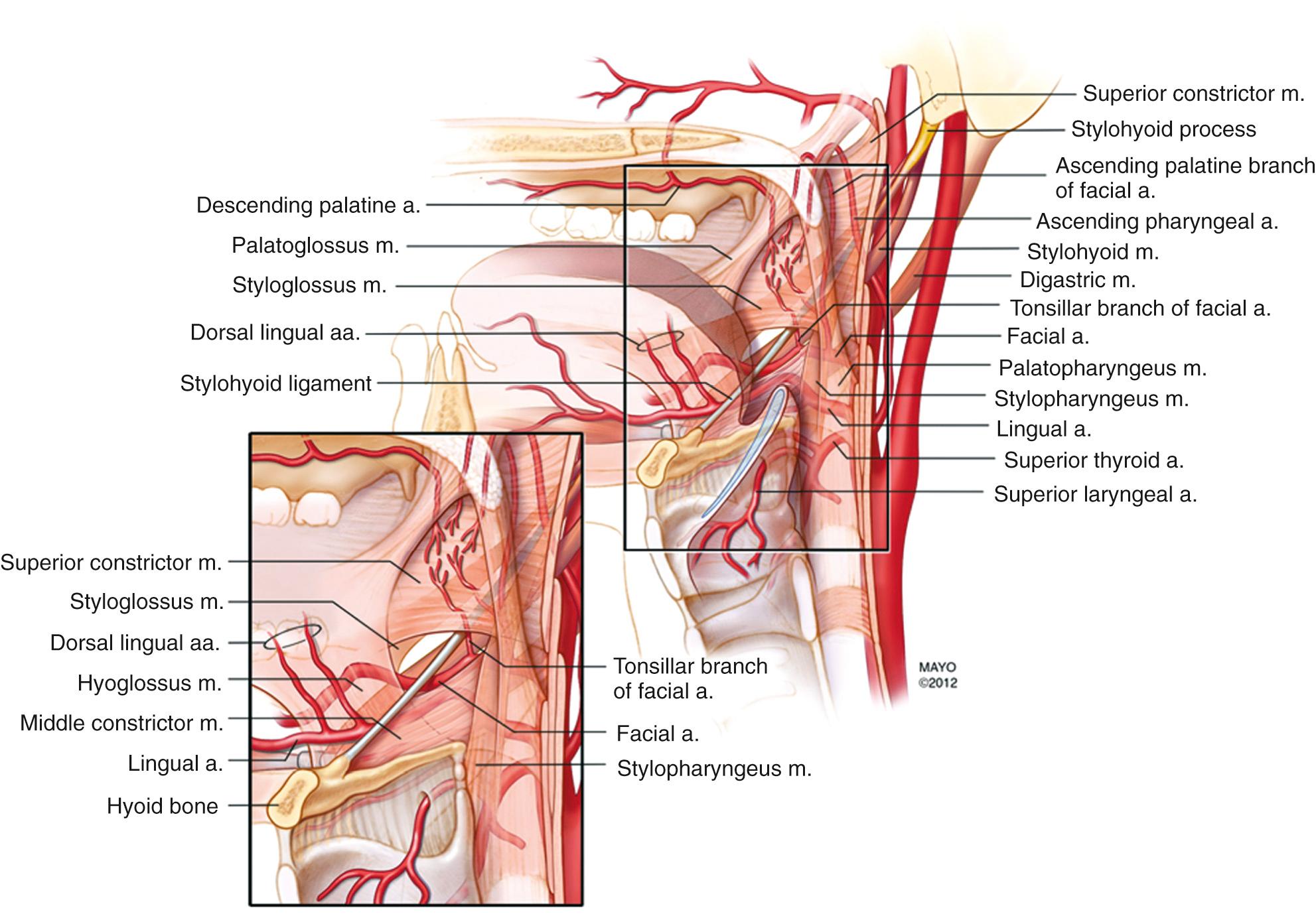
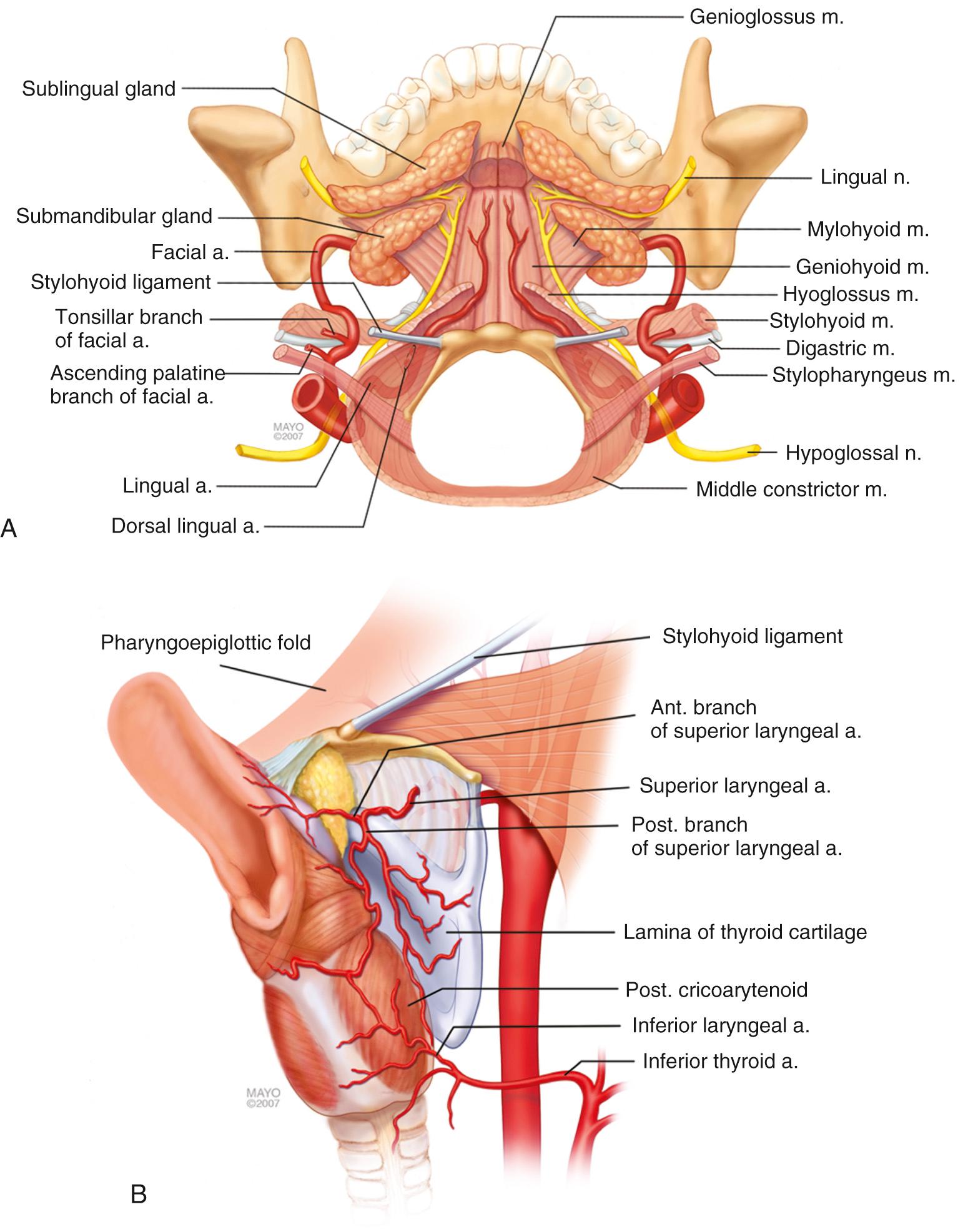
Neighboring the tonsil lies the internal carotid artery (ICA), classically described as lying just posterolateral to the lateral pharyngeal wall, separated from the pharynx by the superior pharyngeal constrictor and the buccopharyngeal fascia. In the majority of patients, the ICA runs a straight course to the skull base without branching. Its exact location varies in an age-dependent manner, lying approximately 1.4 cm from the tonsillar fossa in a 1-year-old and 2.5 cm from the tonsillar fossa in an adult. However, 10% to 40% of the population are expected to have variations, 5% to 6% of which include curving, kinking, and coiling, which may place the ICA at increased risk during tonsillar and pharyngeal surgery. Preoperative imaging is therefore necessary to evaluate the relationship between the ICA, the tumor, and the planned operative site.
An interwoven plexus around the tonsillar capsule and a pharyngeal plexus of veins that drain to the internal jugular vein (IJV) supply venous outflow. In addition, the lingual and facial veins provide venous outflow into the jugular system. The trigeminal and glossopharyngeal nerves via the lesser palatine and tonsillar branches, respectively, provide afferent sensory innervation. The glossopharyngeal nerve descends from the jugular foramen and passes between the IJV and ICA before descending in front of the ICA. It then curves around the stylopharyngeus muscle as it passes between the superior and middle constrictor muscle on its way to innervate the tongue, placing it at risk when operating near the inferior tonsillar pole.
No lymphatic vessels are present in the germinal centers of the palatine tonsils; however, the tonsillar capsule is penetrated by a network of subepithelial lymphatics that includes septal, interfollicular, and subreticular vessels. These lymphatics drain to the upper jugular nodes with a predilection for the jugulodigastric nodes. Metastatic spread to involve levels II, III, and IV is common, and spread to involve level V is also possible. The retropharyngeal (RP) lymph nodes are also at risk for spread from tonsillar squamous cell carcinoma (SCC), most notably when tumors invade superiorly into the soft palate. The RP lymph nodes can be found in the fat pad between the posterior wall of the pharynx and the prevertebral fascia and are divided into medial and lateral (nodes of Rouvière) groups. This lymph node group atrophies with age and is less consistent than what is seen in the lateral neck. In a study designed to carefully examine the rate of malignant spread to these nodes in patients with oropharyngeal SCC (OPSCC), on average a total of 1.4 RP nodes were found per patient. The nodes of Rouvière are at the highest risk for OPSCC metastases, and up to 14.5% of patients with tonsillar OPSCC present with pathologically confirmed nodal metastases.
The boundaries of the base-of-tongue (BOT) area include the circumvallate papillae anteriorly, the glossotonsillar sulci laterally, and the hyoid bone or floor of the vallecula inferiorly. The BOT includes both the pharyngoepiglottic and glossoepiglottic folds. The lymphoid tissue (lingual tonsil) is contiguous with the palatine tonsils at the glossotonsillar sulcus, and similar to the palatine tonsil, it is covered with stratified squamous epithelium on its surface. Again, perforations in this epithelium communicate with lymphatic follicles via clefts. Just deep to the lingual tonsillar tissue lies the intrinsic tongue musculature in three tangential planes: (1) superior longitudinal muscle, (2) transversus and verticalis muscles, and (3) inferior longitudinal muscle. The extrinsic muscles lie deep to the intrinsic musculature and include the genioglossus, hyoglossus, styloglossus, and palatoglossus muscles.
The arterial supply to the BOT arises primarily from the external carotid system via the lingual artery (see Figs. 97.1 through 97.3 ). It branches from the external carotid artery (ECA) at the level of the hyoid bone and runs lateral to the middle pharyngeal constrictor muscle before being crossed by the hyoglossal muscle. At this point it dives deep to the hyoglossal muscle and runs along the superior surface of the hyoid bone ( Fig. 97.4 ). The branches of the lingual artery include the suprahyoid branch, dorsal lingual artery, sublingual artery, and arteria profunda linguae. The arteria profunda linguae passes between the genioglossus and inferior intrinsic musculature (see Fig. 97.3 ). Venous outflow drains to the IJV either directly or via the lingual or retromandibular veins. The lingual branch of the glossopharyngeal nerve supplies sensory and visceral afferent innervation to the BOT. Motor efferent innervation is supplied by the hypoglossal nerve, which is at highest risk during BOT surgery as it passes over the hyoglossus muscle and courses along the superior border of the hyoid bone deep to the digastric and mylohyoid muscles (see Fig. 97.2 ).
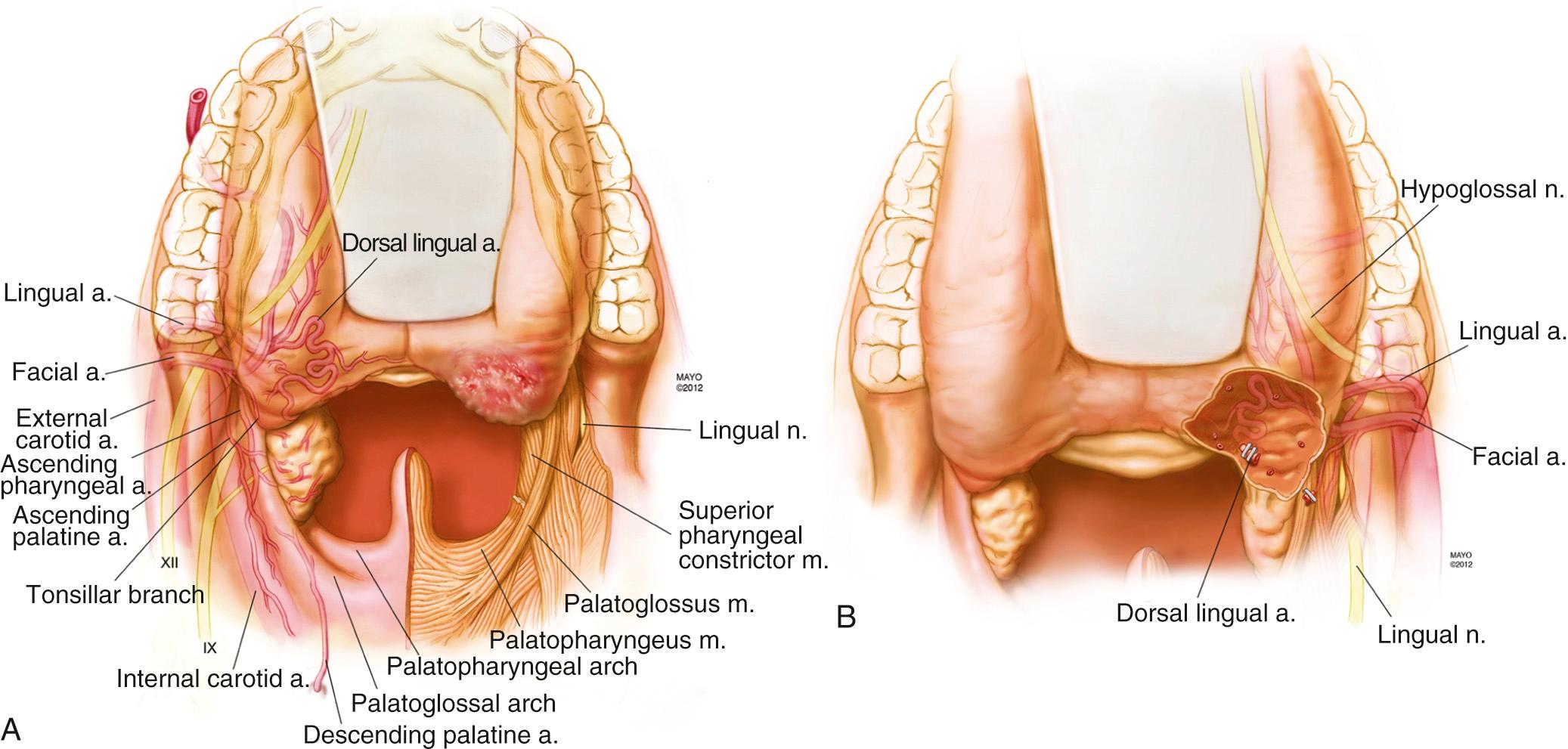
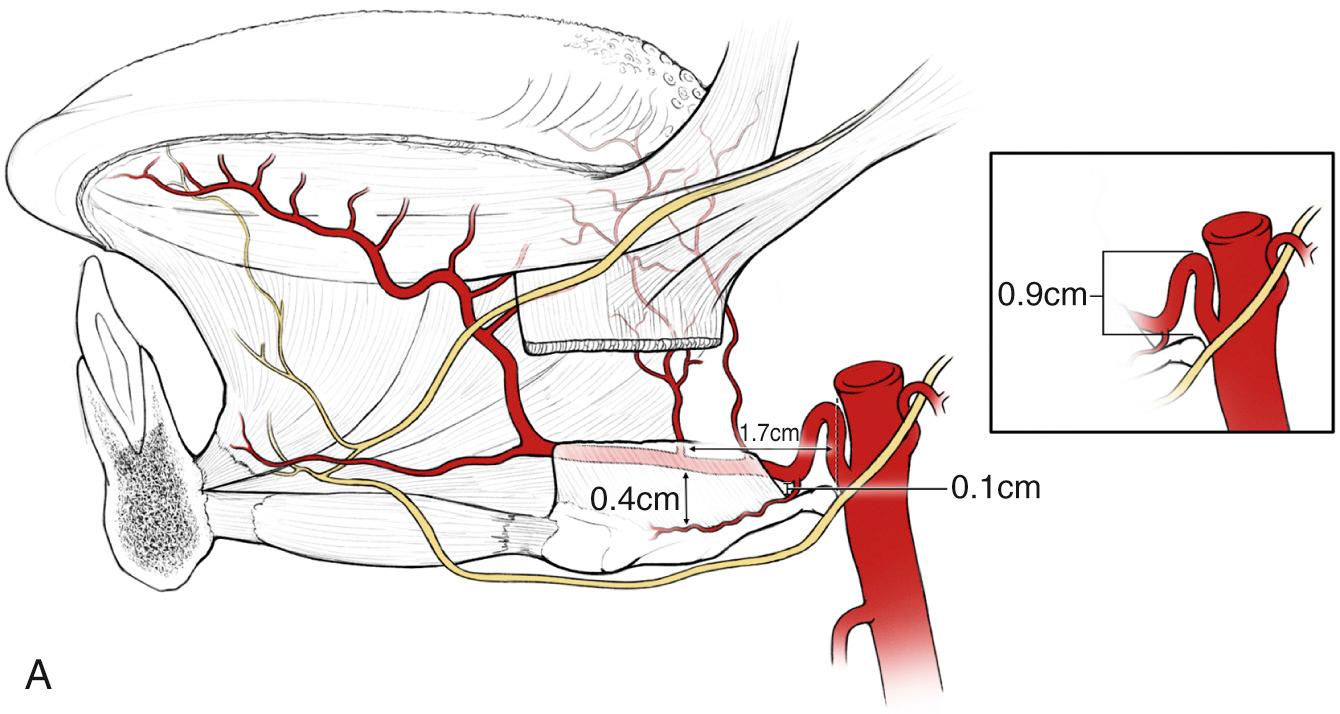
Similar to the palatine tonsil, no lymphatic vessels are found within the germinal centers of the lingual tonsil. However, dense septal, interfollicular, and subreticular lymphatics drain the BOT through channels that run along the lingual veins as they course through the pharyngeal wall to drain into the upper jugular nodes. Each side of the BOT is connected via precollecting vessels that cross the midline to drain to the contralateral side. According to Lindberg, levels II, III, and IV were most commonly involved in BOT tumors, with bilateral metastases to level II being common, and involvement of level V being rare.
The soft palate is bounded anteriorly by the hard palate, posteriorly by the palatopharyngeus muscle and uvula, and laterally by the superior pharyngeal constrictor muscles. The soft palate helps to form the velopharyngeal sphincter and therefore partially separates the nasopharynx from the oropharynx. The muscular components of the soft palate include the superior pharyngeal constrictor, palatopharyngeal, palatoglossal, levator veli palatini, tensor veli palatini, and uvular muscles. The soft palate also contains minor salivary glands and taste buds.
The arterial supply to this region arises from the internal maxillary system as the descending palatine artery, which branches into the greater and lesser palatine arteries (see Figs. 97.1 and 97.3 ). The lesser palatine artery provides the primary blood supply to the soft palate, which anastomoses with small branches contributed by the external carotid system, which includes branches from the ascending pharyngeal artery and very small tonsillar branches contributed by the dorsal lingual artery. In addition, the ascending palatine artery, a branch of the facial artery, curves inward at the upper border of the superior constrictor muscle to course along the levator veli palatini to the soft palate. A small venous plexus flows into the larger pharyngeal and pterygoid plexi, which ultimately drain into the jugular system. The external palatine vein drains the soft palate by coursing anterior to the tonsillar fossa before penetrating the superior pharyngeal constrictor and terminating in larger named veins in the area (facial, lingual, pharyngeal, etc.).
The sensory and visceral afferent innervation of the soft palate arises from branches of the sphenopalatine ganglion. The lesser palatine nerve descends from the sphenopalatine ganglion and passes through the lesser palatine foramen at the posterior edge of the hard palate, carrying sensory fibers through the sphenopalatine ganglion. Fibers are derived from the facial nerve (VII) via the greater superficial petrosal nerve; the mandibular nerve (V 2 ), which provides the majority of sensory innervation; and the posterior cranial or upper spinal nerves. Motor efferent supply to the tensor veli palatini comes from a branch of the mandibular nerve (V 3 ) via the otic ganglion. The remainder of the soft palate musculature receives efferent motor innervation from the cranial portion of the eleventh nerve, distributed via the vagus (cranial nerve X) to the pharyngeal plexus.
The lymphatics of the soft palate have three distinct systems that drain medially to the middle third of the jugular chain, laterally to the RP lymphatics, anteriorly to the hard palate, and subsequently into the submental and submandibular nodal groups. The lymphatics in the uvula drain primarily into the upper jugular chain, whereas the vessels that drain the upper and posterior surfaces of the soft palate drain laterally via the pharyngeal lymphatics to end in the RP nodes. Lindberg found that the incidence of bilateral metastases in SCC of the soft palate was high, likely because of its midline anatomic location, with the jugular nodes the most frequently involved.
The PPW is defined by the superior surface of the hyoid bone (or floor of the vallecula), the soft palate, the posterior tonsillar pillars, and the lateral extent of the piriform sinuses. Stratified squamous epithelium forms the mucosal surface, which covers the superior pharyngeal constrictor muscle and the superior portion of the middle pharyngeal constrictor. Between the mucosa and the constrictors, especially superiorly is the pharyngobasilar fascia, which firmly anchors the superior constrictor to the skull base. The buccopharyngeal fascia envelops the outer aspect of the constrictors. Outside the buccopharyngeal fascia again at this level lies the RP, “danger space,” a potential space that can be involved in the rapid spread of infection or disease into the posterior mediastinum. Beyond this space lies the prevertebral fascia, bound laterally by the transverse spinal processes. PPW tumors are considered midline tumors, and although lateral extension is uncommon, they frequently invade into the RP and prevertebral fascia.
The arterial supply to the PPW arises primarily from the ascending pharyngeal artery (see Fig. 97.1 ). This vessel branches off the ECA and runs superiorly between the ICA and ECA. It then turns to course posteromedially along the pharyngeal wall before continuing on to the jugular foramen. The lateral extent of the PPW may also receive blood supply from the tonsillar arteries described earlier. The pharyngeal venous plexus offers venous drainage along the posterior aspect of the pharyngeal wall; this network of veins is in direct communication with the pterygoid plexus superiorly and the superior thyroid, lingual, facial, or IJVs inferiorly. Pharyngeal sensation is provided by the glossopharyngeal nerve, and motor efferents and sensation are provided by the vagus nerve. As the glossopharyngeal nerve descends from the jugular foramen to cross the stylopharyngeus muscle, it gives off one or more pharyngeal branches. The vagal pharyngeal branches leave the nerve near the skull base and run between the ECA and ICA along the lateral surface of the pharynx. Thus the pharyngeal branches from each nerve join along the lateral aspect of the pharyngeal wall to form the pharyngeal plexus, and they are joined by sympathetic fibers from the superior cervical ganglion.
The lymphatic drainage of the PPW begins as a dense capillary network within the pharyngeal mucosa. This drains primarily into the RP nodes, described earlier, which then preferentially drain into the upper jugular chain and subdigastric lymph nodes, or levels II and III. Ballantyne reported that up to 44% of patients with PPW SCC have positive RP nodes. In addition to this course through the RP nodes, drainage is also direct from the PPW to the lymph nodes in levels II and III.
The basic goal of surgical oncology is to remove all malignant disease while minimizing impact on form and function. This is especially relevant when considering the oropharynx, which plays a critical role in speech, deglutition, and respiration. Although small tumors of the tonsil, palate, and PPW can be accessed relatively easily transorally using bite blocks or mouth gags and a headlamp, large tumors with distal or posterior extension, especially when they arise from or involve the BOT, can be deceptively difficult to reach. For this reason, the majority of oncologic surgical resections for these tumors have historically been performed using open surgical techniques—such as suprahyoid (transhyoid) pharyngotomy, lip-split mandibulotomy (mandibular swing), or pull-through techniques that utilize a visor incision—followed by adjuvant radiation therapy (RT). These approaches provide unparalleled surgical access; however, when combined with postoperative irradiation, they can result in significant morbidity to the patient.
Although specific disease pathologies are not discussed in this chapter, to understand the advances in transoral OP surgery, it is important to understand the history of transoral resection for SCC, which has been the major driver for innovation in this subsite. As data became available implying that primary chemoradiation therapy minimized functional complications without sacrificing oncologic outcomes, the trend in oncologic management moved away from surgical resection at the end of the 20th century. However, primary treatment with chemoradiation therapy was not free of significant complications and early and/or late functional sequelae, which has prompted physicians to continue their pursuit of a minimum access technique that would decrease overall treatment impact, specifically by discarding open approaches in favor of “keyhole” transoral surgical access.
In France, Pierre-Charles Huet began advocating transoral resection of select tonsil cancer in 1951 with good success. Further investigations into this approach by Laccourreye and Holsinger and their colleagues demonstrated comparable oncologic outcomes in a series of 191 patients without the morbidity associated with open approaches. However, for tumors that extend to or arise from the BOT or the distal oropharynx, transoral access continued to be limited. Similarly difficulties were presented by laryngeal tumors, and in 1972, Jako and Strong presented the first successful work describing surgical resection of laryngeal cancer using the carbon-dioxide (CO 2 ) laser.
In 2003, Wolfgang Steiner of Goettingen, Germany, combined these advances with the introduction of transoral laser microsurgery (TLM). Steiner and colleagues published a series of 48 previously untreated patients who underwent transoral resection from 1986 to 1997. Steiner used a distending bivalved laryngoscope to expose the tumors and an operating microscope to visualize the operative field. In this way, the surgeon was able to use two hands, one to mobilize and retract the tumor, the other to operate the laser micromanipulator attached to the microscope for cutting and ablation. Whereas this technique offered improved visualization and access to the BOT and the distal oropharynx, the operation was performed via the barrel of the laryngoscope, which offered a limited view when resecting bulky disease. In addition, incisions made with the CO 2 laser were limited to cuts tangential to the straight-line axis of the laser, which further limited the surgeon's ability to make angled cuts around bulky tumors. These constraints forced surgeons to consider violating a tenet of oncologic surgery set in place by Halsted in the early 1900s: removal of an unviolated tumor specimen with a large cuff of surrounding normal tissue , or en bloc resection. To achieve complete surgical resection using TLM, Steiner advocated multi-bloc resection and narrower margins. Pearson and Salassa explain that whereas cutting through a tumor with a blade could theoretically expose viable tumor, which could be carried on the blade to an adjacent site and result in tumor seeding, the use of a laser beam as the cutting tool eliminates the physical object or vehicle. Despite this significant departure from the gold standard for tumor resection, Steiner and coworkers reported a local control rate of 85% with no recurrences in T1 to T2 tumors and a 20% recurrence rate in T3 to T4 tumors, which suggests that particulate, narrow-margin resection did not compromise oncologic outcomes. Importantly, these data also suggested excellent functional outcomes, and 92% of patients tolerated a normal diet, and no patient required prolonged tracheotomy.
According to Steiner and Ambrosch, this technique was attractive for several reasons. It offered excellent local control of the primary tumor with the least chance of overtreating or misstaging. It offered the best surgical chance for a serviceable voice and normal postoperative swallowing, and patients were more frequently able to avoid tracheostomy. If the tumor ultimately could not be resected transorally, the surgeon could still convert to open approaches; and in the event of recurrence, all options—including laser excision—would still be available. Despite this early success, several additional studies that duplicated these results were required to convince the surgical community that TLM was a viable option for managing BOT and distal OP tumors. Since that time, TLM has gained wide acceptance and implementation as an oncologically sound transoral option for managing OP neoplasms.
Despite its relative success, the TLM procedure itself is limited by difficulty with illumination, visualization, and tissue manipulation and ablation. Steiner himself stated that transoral resection of the base of tongue through a laryngoscope was disorienting because the surgeon could often only see a portion of the tumor, and surrounding landmarks were hidden from visualization. In addition, the CO 2 laser is not ideal for hemostasis because it requires the surgeon to alternate between cautery and clips. Finally, the procedure is technically challenging, and it requires specific training and significant experience. These limitations set the stage for investigating surgical robots, which offer the ability to access hard-to-reach areas of the body through keyhole incisions or natural orifices. The da Vinci Surgical System from Intuitive Surgical (Sunnyvale, CA) offers the surgeon outstanding visualization via binocular 0- and 30-degree cameras, 540 degrees of wristed instrumentation, tremor reduction, and an ergonomic operating position. However, initially, the utility of transoral robotic surgery (TORS) was limited because of the size of robotic instrumentation and lack of appropriate retractors.
In 2005, Neil Hockstein, from the University of Pennsylvania, and his colleagues first introduced the da Vinci system into the otolaryngology literature. His group adapted the da Vinci robot to work via transoral access and evaluated the safety and feasibility of TORS using first cadaveric and then canine models, followed by human patients. Within the year, Ian McLeod and Patrick Melder from the Walter Reed Medical Center published a report that documented the successful resection of a vallecular cyst in a human using the da Vinci system. This led to a relative deluge of TORS and da Vinci studies in the head and neck literature, as researchers explored new applications in head and neck surgery. TORS overcame several of the limitations inherent to TLM by offering surgeons the freedom to perform precise open surgical maneuvers with exceptional three-dimensional (3D) endoscopic visualization. These initial reports spurred a huge interest in da Vinci applications, which culminated in the U.S. Food and Drug Administration granting approval for TORS for select tumors of the “throat and voice box”; however, the technique is not appropriate for all transoral applications. Whereas oropharyngeal lesions such as BOT lesions are ideally suited for robotic resection, patients with tumors visible by direct line of sight, such as tonsil or palate tumors, may not benefit from a TORS procedure.
When choosing a transoral approach to the oropharynx, it is imperative to consider the goals of oncologic resection, that is, complete tumor resection with negative margins with the preservation of form and function. The choice of direct transoral resection (DTR) versus TLM versus TORS is less important, in that each of these techniques offers unique advantages and disadvantages that must be understood in the context of the patient, their tumor, and the surgeon performing the resection. The surgeon must therefore have an excellent working knowledge of the tools available for transoral surgery and must be adept not only at transitioning between them but must also understand when it is necessary to transition to open approaches.
Case selection for transoral surgery can be divided into physiologic, anatomic, and oncologic constraints ( Table 97.3 ).
| Physiologic | Anatomic | Oncologic |
|---|---|---|
|
|
|
Patients who undergo transoral surgery should possess the cardiovascular and respiratory fitness to tolerate the stress of a general anesthetic and major surgical intervention.
The patient ideally should be able to come off any medical anticoagulation and should demonstrate normal clotting ability.
The patient should also be free of immune-related deficiencies that may impair wound healing by secondary intention.
Recent weight loss of more than 10% of the patient's body weight or other evidence of malnourishment should signal the physician to consider nutritional repletion prior to surgical intervention.
Mouth opening:
The intricate relationships between the mandibular arch length and width, the size and shape of the tongue, and the length and position of the incisor teeth can significantly affect the ability to gain transoral exposure.
Low Mallampati score ( Fig. 97.5 ):
As the surgeon becomes more experienced with transoral surgery, anticipation of the ease or difficulty of operative transoral exposure improves.
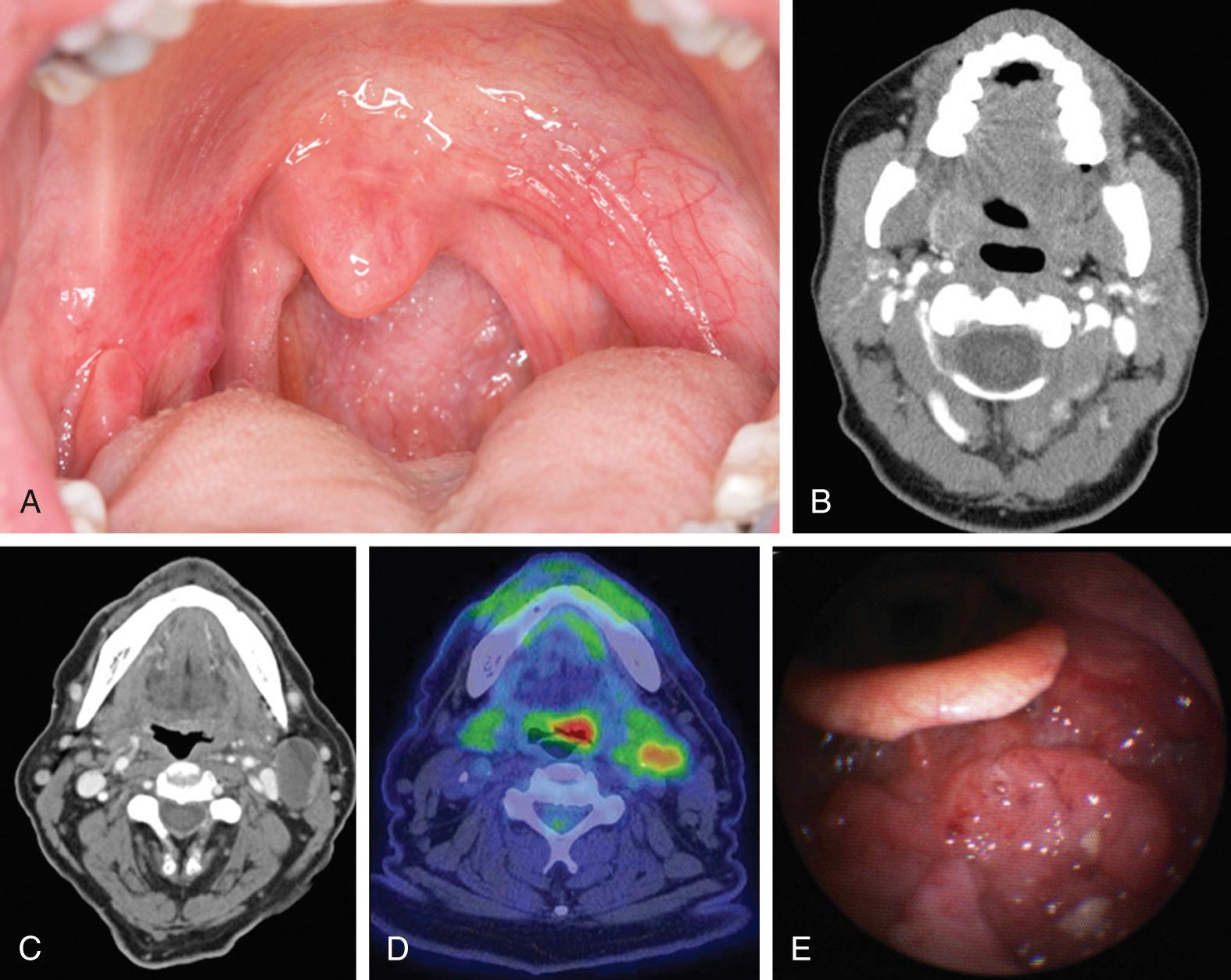
Exophytic and mobile tumors are more ideally suited for transoral removal.
The size of the tumor as reflected in the tumor/node/metastasis staging system is not the most relevant factor.
The mobility of the tumor is best assessed by palpation during office examination.
As the tumor grows into the deep intrinsic muscles of the tongue, the extrinsic muscles of the tongue, or the lateral pharyngeal wall constrictor muscles, it becomes less mobile and much more difficult to expose and excise transorally.
Patients with exophytic tumors will rarely complain of local or referred pain, significant dysphagia, and malaise.
Patients with ulcerative endophytic tumors will often complain of otalgia, odynophagia, trismus, and speech alteration. OP tumors that are immobile on palpation often involve the medial pterygoid muscle, mandible, maxillary tuberosity, hyoid bone, or parapharyngeal structures.
Tumor extent that requires removal of more than 50% of the BOT or more than 75% of the soft palate is a relative contraindication to transoral surgery ( Box 97.1 ).
Skull base invasion
Invasion or encasement of the great vessels
Invasion of the mandible
Confluence of primary and neck disease
Tumor extension the surgeon cannot confidently clear transorally
Absolute contraindications to transoral surgical treatment of OP cancer are invasion of the skull base, invasion or encasement of the great vessels, invasion of the mandible, confluent extent of the primary tumor and neck metastasis, or tumor extension where the surgeon is not confident that the tumor can be completely removed. (Debulking of the tumor and then relying on chemotherapy and RT to “clean up” the remaining disease violates the principles of oncologic surgery and results in lower than acceptable oncologic cure rates.)
Revision treatment and salvage transoral surgery after chemoradiation can be performed, but the oncologic cure rates are lower in this setting and the complication rate is higher.
In summary, the ideal patient for transoral OP cancer surgery has a mobile exophytic tumor and the body habitus to allow easy visualization of the tumor transorally ( Figs. 97.6 and 97.7 ).
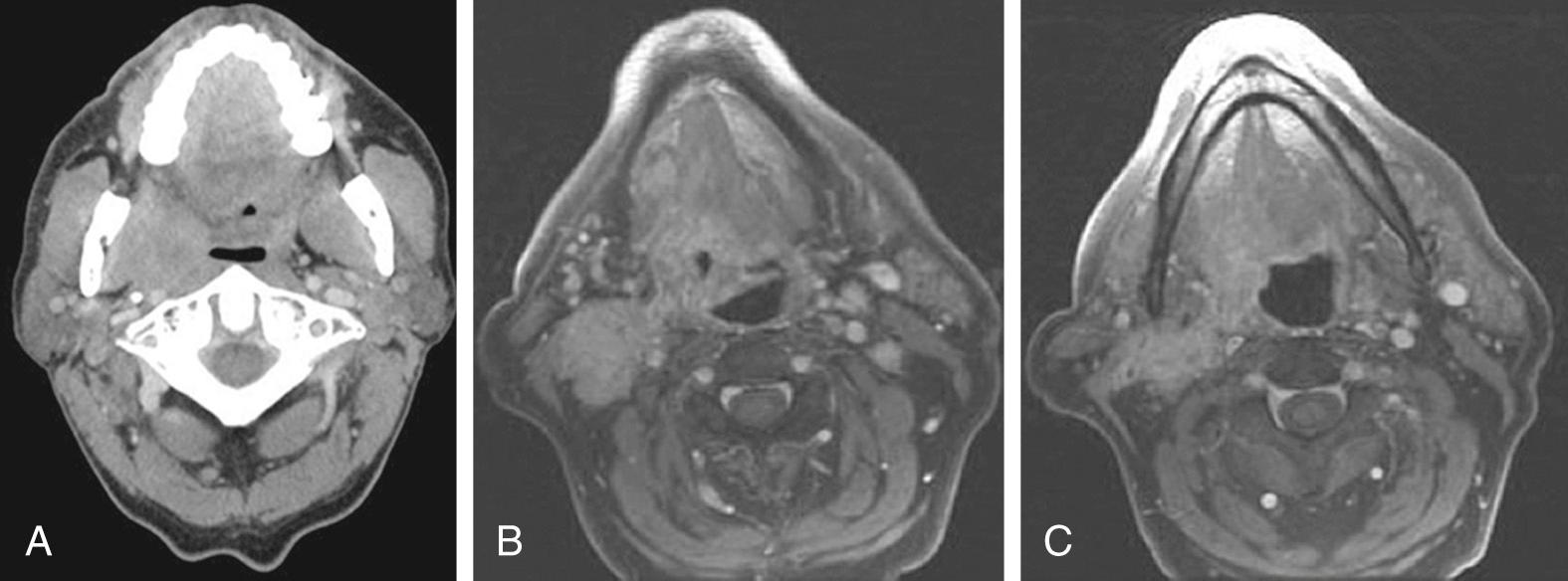
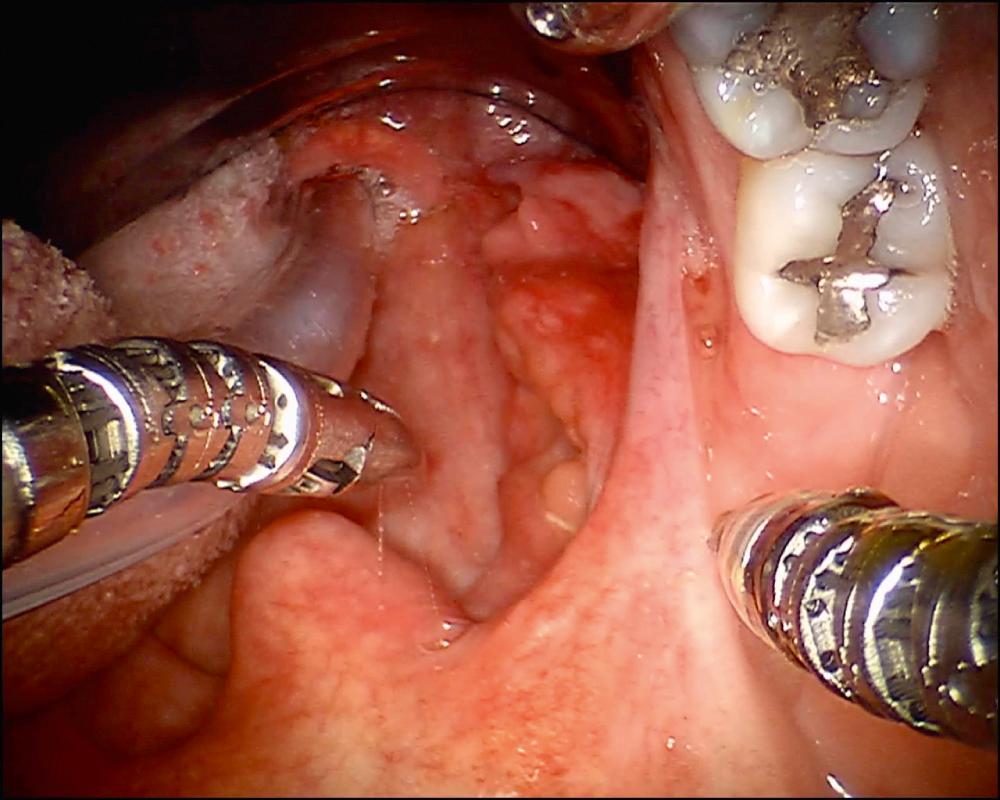
Regardless of technique used, the first hurdle in successful tumor resection is safe, effective tracheal intubation and induction of anesthesia. This is certainly made more difficult in patients with OP neoplasms. The American Society of Anesthesiologists Task Force on Management of the Difficult Airway defines a “difficult airway” as the clinical situation in which a conventionally trained anesthesiologist experiences difficulty with facemask ventilation of the upper airway, difficulty with tracheal intubation, or both. Understanding options available for patients with difficult airways is essential.
The choice of intubation technique must be individualized based on the patient's anatomy, tumor characteristics, and planned operation. It is important to discuss both a preferred airway plan and a backup airway plan with the surgical and anesthesia teams. Considerations for approach include intubation under general anesthesia after successful mask ventilation versus awake or sedated intubation. Routes of tracheal intubation include transoral, transnasal, and transcervical approaches, and all can be performed with the patient awake, sedated, or under general anesthetic after mask ventilation. Direct laryngoscopy using traditional laryngoscopes or the GlideScope (Verathon, Bothell, WA) can facilitate transoral intubation, and fiberoptic intubation can be used for both transoral and transnasal approaches. Fiberoptic intubation is advantageous in that it allows direct visualization of the anatomy and pathology en route to tracheal intubation and has become one of the preferred methods in difficult airway patients. Awake tracheostomy is reserved for patients with extensive, and often friable, tumors that obstruct the view of the larynx and might bleed during manipulation with fiberoptic endoscopy. Transnasal intubation can be advantageous during transoral OP resection, as it moves the endotracheal tube (ETT) out of the oral cavity and away from the base of tongue. Tracheostomy should be considered in patients in acute airway distress as a result of upper airway obstruction; patients with bulky, friable pharyngeal tumors; patients who will ultimately require tracheostomy as a result of their planned operative procedure; and those who are at high risk for a difficult intubation.
After deciding on the intubation approach, it is equally important to consider the type of ETT to be used during the case ( Fig. 97.8 ). Factors to consider include the position of the tube, the risk for compression or kinking, and the risk of airway fire. Right-angled ETTs (RAE tubes) are available for both transoral and transnasal intubation. An RAE tube can help direct the proximal end of the tube away from the operative field. The majority of tongue blades used with mouth gags during transoral surgery have a groove to accommodate an oral-down RAE tube to prevent compression of the tube and to keep it out of the operative field. The limitation with RAE tubes is that the majority are clear polyvinyl chloride (PVC) tubes, which can be compressed or kinked and are at relatively high risk for combustion. To prevent airway compromise associated with ETT kinking, armored or reinforced tubes can be used that contain a tempered steel reinforcing wire wound in a spiral that extends from the cuff to the connector within the wall of the tube. This is relevant in transoral operations when the operative plan includes retraction of the ETT out of the surgical field. Although resistant to kinking, armored tubes are not impervious to this complication; when kinking does occur, it may result in an emergent airway situation, if the tube is compressed to such a degree that it is irreversible. In addition, despite the stainless steel reinforcement, armored tubes are not impervious to combustion.
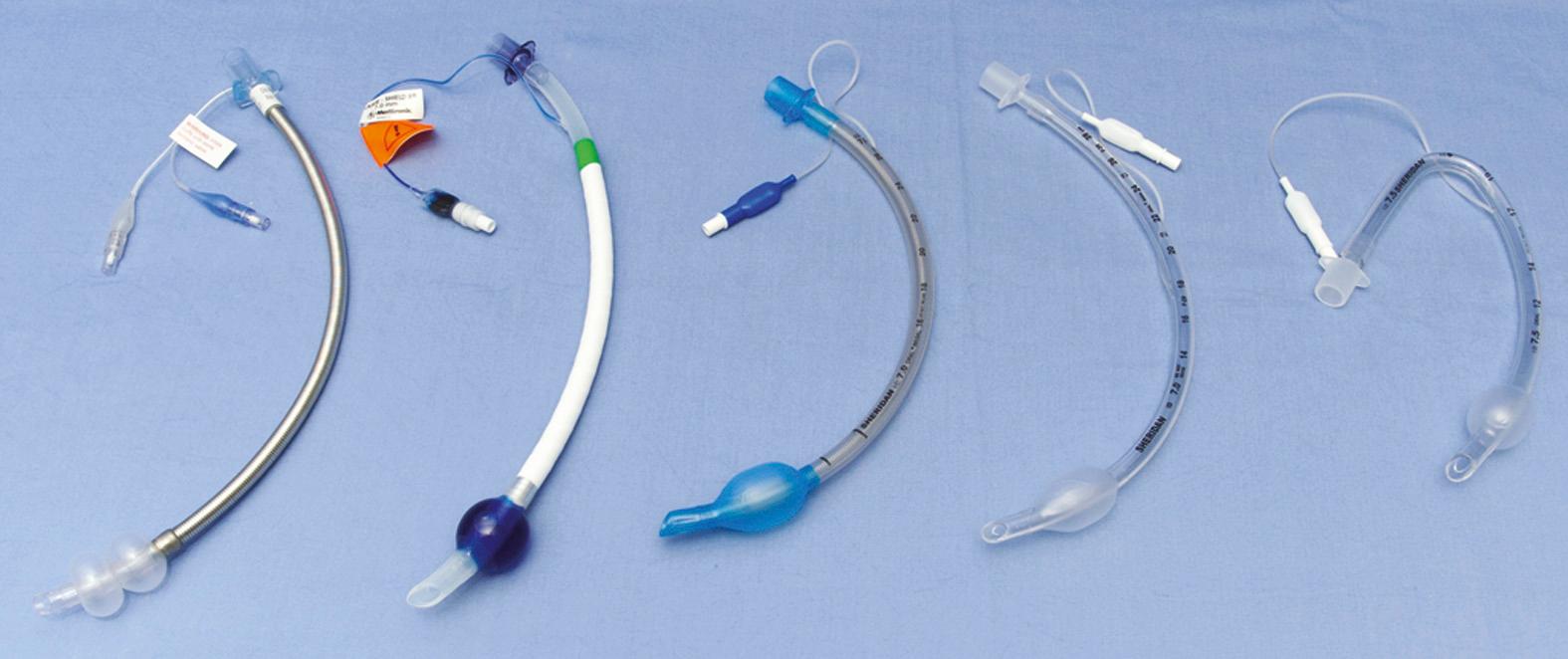
Airway fires are a serious and potentially life-threatening complication of OP surgery when using either electrocautery or laser energy. Although a multitude of case reports in the literature highlight the risk of OR fires during various head and neck procedures, when Smith and Roy surveyed members of the American Academy of Otolaryngology–Head and Neck Surgery in 2011, they found that 25% of surgical fires were reported during OP surgery. Fire classically requires an ignition source, an oxidizer, and a fuel substrate. In OP surgery, this classic “triad” is supplied by electrocautery or laser energy, oxygen and nitrous oxide, and ETTs or other materials such as sponges, suction tubing, OP tissue, char, and suture material.
Electrosurgical units have been shown to ignite and propagate a fire at 15 W, when the fraction of inspired oxygen (FiO 2 ) is greater than 50%. Whereas fires have been reported with several different lasers, the carbon-dioxide laser is most commonly involved. In a study to evaluate the in vitro risk of airway fire, Li and colleagues found that ignition of a PVC ETT could be effectively avoided when the ETT cuff was filled with water instead of air, the FiO 2 was maintained at less than 40%, the laser wattage was kept at 8 W or less, and the laser was set on the intermittent stimulation mode. Based on studies such as those discussed earlier, most authors recommend maintaining the lowest FiO 2 possible, and many institutions recommend using an FiO 2 of 30% or less, when possible, and minimizing air leaks around the cuff of the tube. Finally, when considering fuel, the most common culprit in OP fires is ETTs; therefore the surgeon should carefully consider the type of tube used and the risk of each.
It is well documented that PVC tubes are vulnerable to combustion when impacted by either electrosurgical or laser energy in the presence of oxygen or other oxidizing gases that exceed the oxygen index of flammability (26.3%). Of note, the majority of armored or spiraled-wire ETTs are made of PVC; although more difficult to ignite, they should be treated similarly. The final ETT choice is the laser-resistant tube. In 1978, Vaughan showed that wrapping metallic tape around an ETT reflected or dispersed laser energy and thereby protected the tube from ignition. Available laser-resistant ETTs include PVC tubes wrapped in copper or aluminum foil tape, or the Laser-Guard protective coating (Merocel, Mystic, CN). In addition, tubes such as the Xomed (Jacksonville, FL) Laser Shield II and stainless steel Laser-Flex tubes (Mallinckrodt, St. Louis, MO) are also available. Whereas each of these tubes provides improved fire safety when compared with plain PVC tubes, their en vivo safety may vary significantly as the tube surface is altered with the presence of blood, fluid, and so on. Sosis and colleagues investigated the safety of each tube, both before and after the application of human blood to its surface, and found significant variability among products, with the Laser-Guard protective coating and the Xomed Laser Shield II providing superior fire safety. This study used a CO 2 laser power of 38 W, which is significantly higher than that used in clinical practice; therefore it likely underestimates the safety of the other laser-resistant tubes.
Finally, after considering the fire risk presented by the milieu within the oropharynx, it is important to consider the additional precautions that should be enforced to provide maximum safety to both patient and personnel when using surgical lasers. Several laser safety protocols have been published, but the predominant considerations for personnel protection include (1) posting signs to indicate that a laser is in use, (2) providing laser-safe eyewear at the entrance to the OR, (3) providing laser-safe eyewear to all OR personnel, and (4) alerting staff and anesthesia when initiating laser use. In addition, patient-specific considerations include (1) covering the patient's eyes, skin, and hair with wet towels and ensuring these remain moist throughout the case; (2) using ebonized instruments when possible to minimize the reflection of laser energy to unintended surfaces; (3) using a laser-safe ETT; (4) maintaining the laser in a holster or covered by wet gauze and in standby mode when not in use; (5) maintaining the lowest possible FiO 2 , utilizing a suction evacuation system to reduce both FiO 2 and any smoke present in the operative field; and (6) ensuring that a basin of water with irrigation tubing and syringe are in the field and ready to be used for irrigation in the event of fire.
The first category of equipment to consider is the mouth prop ( Fig. 97.9 ).
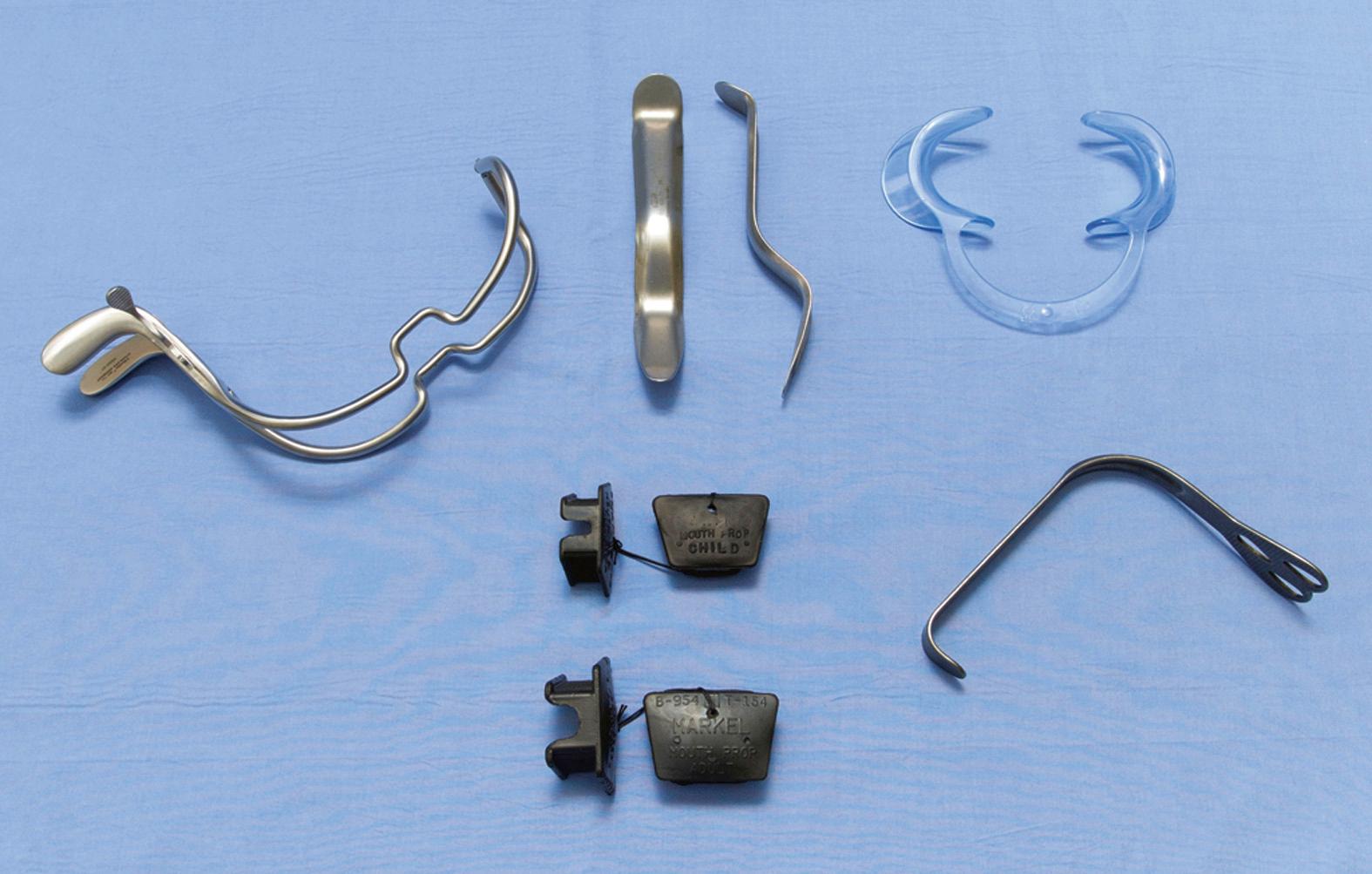
Bite block: available in adult and child size.
Side mouth props: Available styles include the Molt, Doyen, Doyen-Jansen, Denhardt, Jennings, and Ferguson mouth props. These devices are not commonly used in transoral OP surgery, but they are important to be familiar with in the event that a specific tumor cannot be adequately exposed using a more traditional transoral retractor or mouth gag.
A tongue stitch can be placed directly through the distal oral tongue using size 0 silk suture or some similar material.
Weider (sweetheart) or Andrews tongue retractors can be used to retract and reposition the tongue throughout the case (see Fig. 97.9 ).
Lip retraction: Band retractors or Minnesota retractors held by an assistant or plastic cheek retractors can be used (see Fig. 97.9 ).
Mouth gag retractors displace the tongue as well as open the mouth to gain access to the oropharynx ( Fig. 97.10 ).
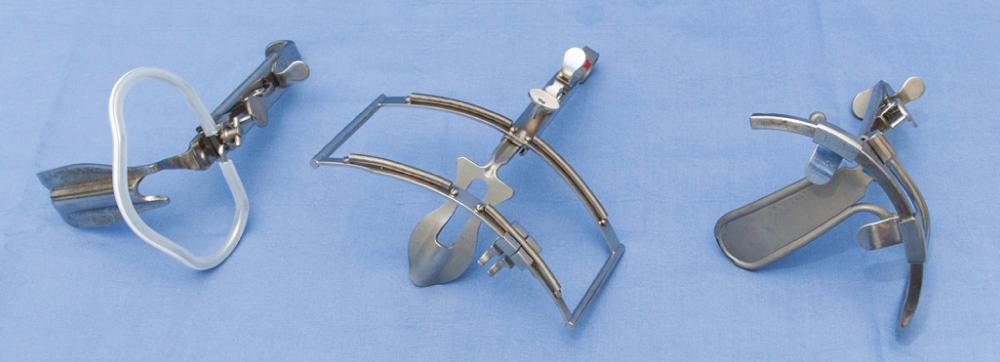
Available mouth gags include the Crowe-Davis, McIvor, Dingman, and Kilner-Dott.
The Feyh-Kastenbauer (Gyrus) retractor is commonly used to access the oropharynx ( Fig. 97.11 ). The tongue blades available for this retractor are unique in that they come in several nontraditional shapes and sizes and are adjustable in an anterior/posterior plane, both of which help facilitate access to the base of the tongue.
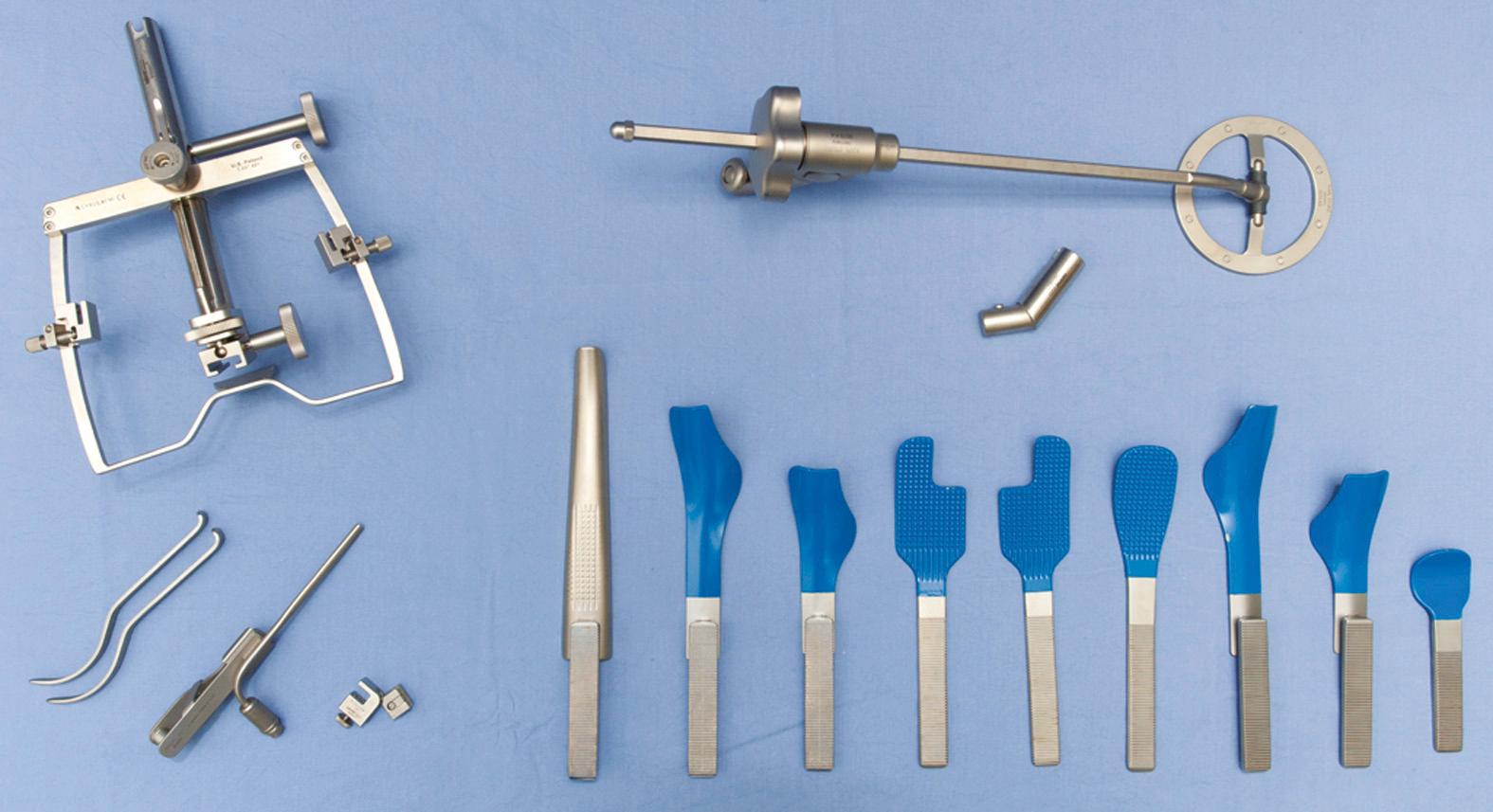
Those most commonly used for TLM include the Kleinsasser laryngoscope (Karl Storz, Tuttlingen, Germany), the Hinni Laryngoscope (Storz), and the Steiner oropharyngoscope. Each of these instruments can be used with an adjustable side plate that can be secured to the bed in any position.
More traditional laryngoscopes can also be used for specific indications that offer adequate exposure. For example, Nagel and colleagues report the use of either the Lindholm or Bouchayer laryngoscope for lingual tonsillectomy in the setting of an unknown primary tumor, owing to the fluted elevated tip.
A variety of rigid microsurgical instruments are available for transoral OP operations ( Fig. 97.12 ). The transoral surgeon should have a combination of these instruments readily available to assist with surgery:
Graspers with straight and angled jaws
Suction cannulas
Endoscopic laryngeal clip appliers (Storz)
Handheld microsurgical unipolar and bipolar suction cautery devices
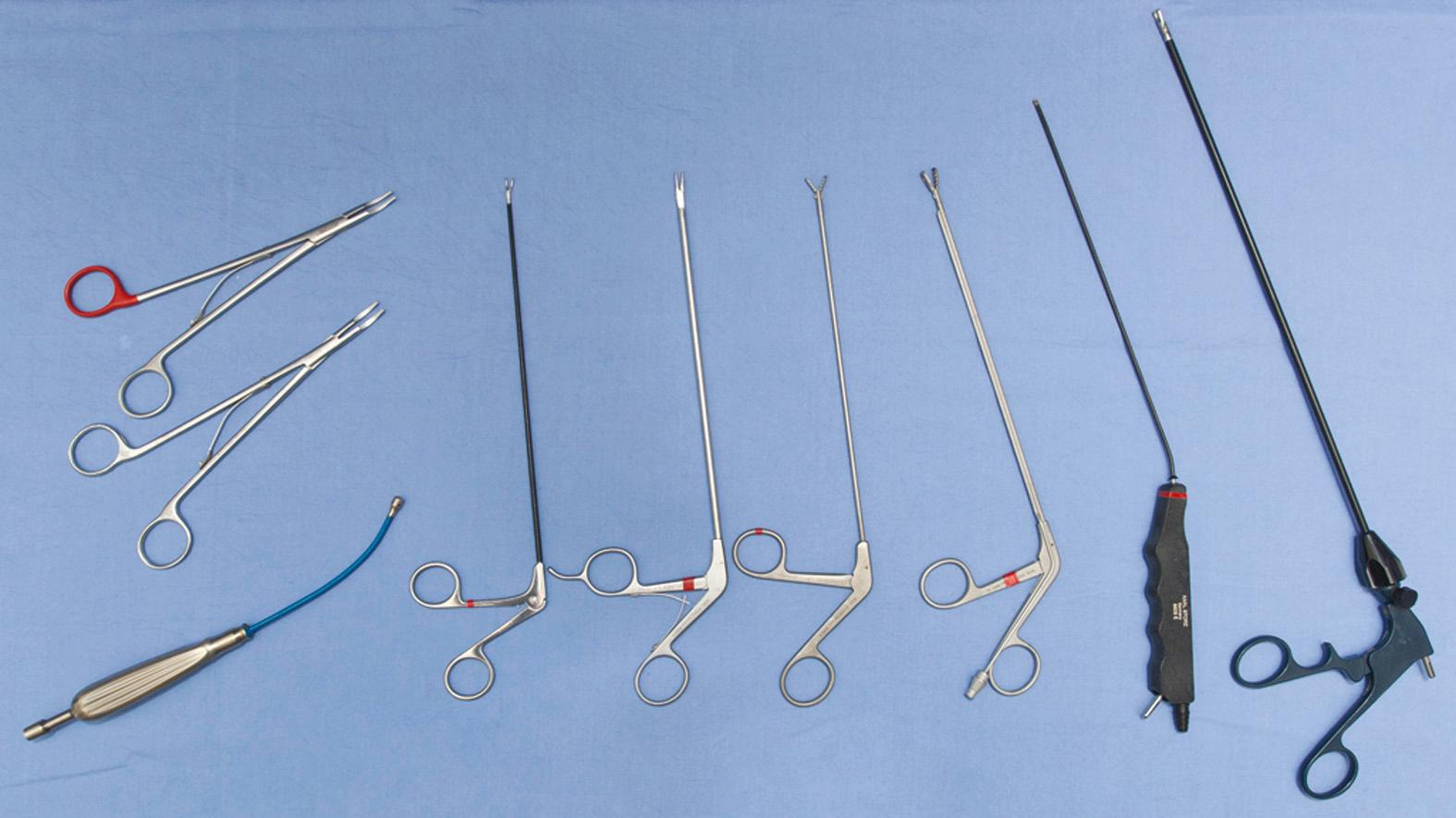
The most common instruments used with the da Vinci robot (Intuitive Surgical) during TORS are the EndoWrist 5-mm Shertel grasper (Intuitive Surgical), the 5-mm Maryland dissector, and the 5-mm monopolar cautery (Intuitive Surgical).
5- and 8-mm needle drivers (Intuitive Surgical) are available and are commonly used when sewing with the da Vinci.
Become a Clinical Tree membership for Full access and enjoy Unlimited articles
If you are a member. Log in here